Vehicle Sales Decline: Understanding the Shift
When talking about vehicle sales decline, the steady drop in new car purchases across markets. Also known as auto market contraction, it signals a broader change in how people move, spend and think about transportation. This trend sits inside the larger automotive industry, a sector that produces, sells and services motor vehicles worldwide. The industry relies heavily on consumer demand, the willingness and ability of buyers to spend on new vehicles, which can swing fast when the economic slowdown, a period of reduced GDP growth and job security hits households. Meanwhile, the rise of electric vehicles, battery‑powered cars that promise lower emissions reshapes buyer expectations and dealer inventories. In short, vehicle sales decline reflects reduced consumer demand, a lagging manufacturing output, and a shifting preference toward cleaner transport options.
Key Factors Behind the Drop
One major driver is manufacturing output, the total number of vehicles produced in factories each month. When factories cut shifts or pause lines due to chip shortages, labor disputes or raw‑material price spikes, the supply side tightens, and dealers often lower prices to move whatever stock remains. This creates a feedback loop: lower inventory can mask demand, while high inventory forces discounts that further erode brand equity. Add to that supply chain disruptions, delays in transporting parts and finished cars, and the whole system feels the strain. Consumers also see more viable alternative transport, options like ride‑hailing, bike‑sharing and improved public transit that reduce the need for a personal car. Sustainability concerns push buyers toward electric vehicles again, yet the higher upfront cost and limited charging infrastructure in many regions keep adoption rates modest, leaving a gap that traditional internal‑combustion models can’t fill. All of these elements—manufacturing output, supply chain health, alternative transport, and sustainability trends—interact to shape the current sales dip.
Despite the gloom, the decline opens doors for smarter strategies. Companies that analyze real‑time sales data can re‑allocate production to match local demand, reducing waste and boosting local economy, the flow of jobs and income within a region. Investing in flexible factories lets manufacturers shift between electric and conventional models without costly re‑tooling, while partnerships with renewable‑energy providers can lower operational costs and appeal to eco‑conscious buyers. Lessons from other sectors, like the rise in plastic demand, where recycled materials found new markets, show that repurposing existing assets can unlock growth. By aligning product portfolios with changing consumer habits, offering transparent financing for electric cars, and emphasizing the societal benefits of reduced emissions, firms can turn a sales slump into a catalyst for long‑term resilience. Below you’ll find a curated set of articles that dig deeper into each of these angles, from supply‑chain fixes to consumer‑behavior insights, giving you practical tools to navigate the evolving automotive landscape.
Why Aren’t Cars Selling in India? Real Reasons Behind the Slowdown
Car sales have dropped sharply across India in 2025. Here’s why Indians are refusing to buy new cars, what’s spooking the market, and what this mess means for the future.
- manufacturing
- India
- food processing
- garden tips
- rice cultivation
- government schemes
- balcony garden
- urban gardening
- balcony gardening
- profitable business
- business ideas
- plastic manufacturing
- drip irrigation
- plant care
- steel manufacturing
- sustainable gardening
- startup ideas
- steel industry
- flower gardening
- textile manufacturers






